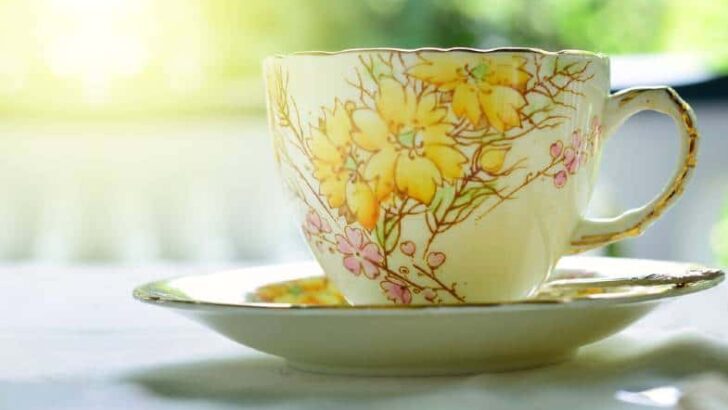I had boxes of beautiful old fine china from my grandmother, which were collecting dust. They were too ornate for me to use on a regular basis, but it was a shame to keep them boxed up. I started to wonder, who much does fine china sell for? So, I began to look into it, and this is what I learned…
China pieces are priced depending on their condition, brand, rarity, style, and age. Antique Fine China items are popular collectibles. Regardless, pricing might vary from piece to piece and brand to brand.
Most Fine China kitchenware includes a back stamp that will assist you in identifying the brand/company. Look up the company’s online registry, and you should be able to uncover the exact price for your piece. You can also check the online marketplace and check how much other individuals sell it for.
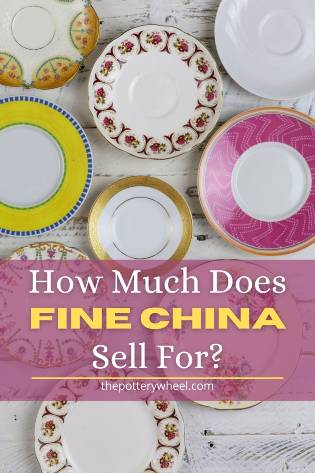
How To Tell If Old Fine China Is Valuable?
Antique Fine China may be valuable, especially if it is a rare piece from a well-known maker. However, determining the worth of your China may be difficult, especially if you don’t know what to look out for.
When determining the worth of Fine China, the first step is to check for the manufacturer’s hallmark. The hallmark is usually located at the bottom of your piece. It usually contains information such as the country of origin, a picture, initials, or even a name.
Most manufacturers brand their products with an identifying symbol, a sequence of numbers and letters, their name, or the country of origin. The hallmark may be painted, printed, stamped, or incised on the object.
Once you have identified the hallmark, take a photo of it and compare it to other hallmarks in Fine China registries or internet sites that give this information. Once you’ve recognized the hallmark, you’ll be able to determine the maker of the China as well as its age.
England has the most precious Fine China. To determine if a piece is from England, look for a crown or comparable emblem on the back. Because current producers employ hues like lime green, teal, and even purple to paint their China, these items are of less value than earlier, more conventional designs.
What Is the Most Collectible Fine China?
Fine China became popular in Western Europe immediately after its first introduction in the 16th century, and its popularity has not diminished since.
In contrast, the original Chinese designs included scrolls, dragons, waves, flowers, and other fortunate Chinese and Buddhist symbols.
European designs evolved to represent themes recognizable to the Western market, such as ancient Roman landscapes or Dutch windmills seen in early Wedgwood China patterns.
However, the original designs are still sought-after by a lot of people. Some of the reasons why people continue to acquire vintage designs are their beauty and distinctiveness.
What Is the Most Expensive Fine China?
So, how much does fine china sell for? Here are some of the more expensive types of fine china and their sale prices:
1. Qing Dynasty Porcelain
A wealthy Chinese entrepreneur paid $84 million for an intricately adorned 18th century Qing Dynasty Fine China vase. This is the only Fine China piece that has ever been sold at such a top-notch sum of money.
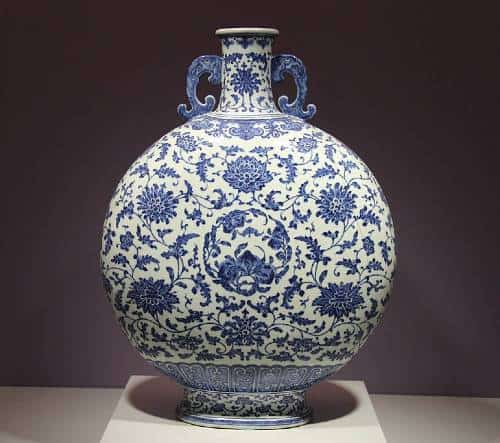
Gary Todd, CC0, via Wikimedia Commons
2. Blue and White Porcelain
Cobalt blue’s origin is Henan Province in China and dates back to the 9th century. It is a 500-year-old Imperial Vase that has a beautiful white and blue color.
It was bought by an anonymous bidder at a staggering $21.6 million at a Sotheby’s public sale in Hong Kong. That sale price makes it the most extravagant item of Blue White Fine China to be ever auctioned.
3. Jihong Porcelain
There are no more than 100 Jihong Fine China pieces in the world. In 2006, a rare Copper-Red Under glazed Ming Dynasty Vase sold for $10 million at a Christie’s auction in Hong Kong.
The beautiful pear-shaped porcelain vase, dating from the early Ming Dynasty period (1368-1644), was presented to a Macau Museum by the buyer.
4. Blood Red Porcelain
In the 10th century during the Tang Dynasty, the earliest red Fine China was created with copper red glaze. A Red Fine China Bowl with dual lotus blossoms was sold for $9.5 million during a Sotheby’s auction.
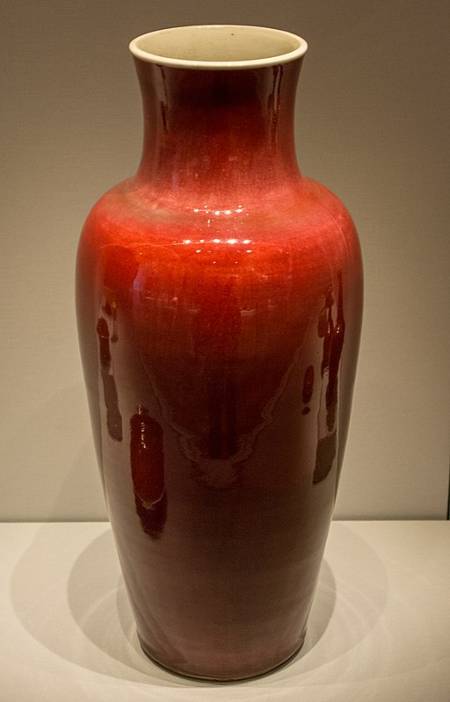
Tim Evanson from Cleveland Heights, Ohio, USA,
CC BY-SA 2.0, via Wikimedia Commons
5. Joseon Porcelain
At a Christie’s auction in New York, a rare unpainted Joseon White Fine China Jar was sold for $1.2 million. The 18th-century jar is 22 inches tall and has everything you need.
The most expensive Joseon Fine China item ever sold was a $4.2 million White Ware Vase Painted in Cobalt Blue, portraying a bearded mountain spirit pulling on a tiger’s tail.
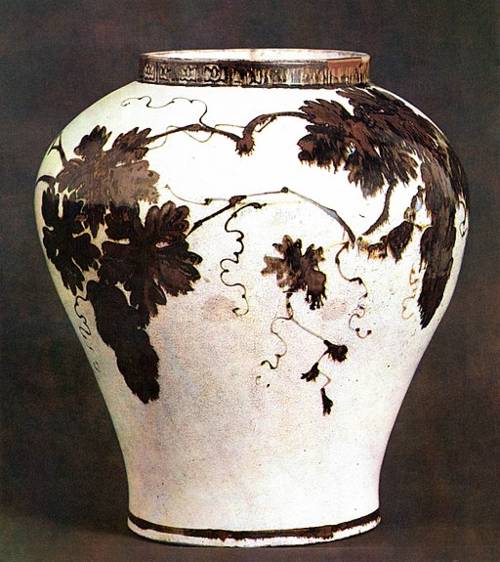
Unknown author, Public domain, via Wikimedia Commons
How Can You Tell Fine China Is Antique?
Antique China might be difficult to find depending on the pattern and design. This is particularly true when it comes to serving pieces, which may be rather costly.
It’s also crucial to remember that the older Chinas will most likely be chipped, cracked, or scratched over time. Make a thorough inspection of each piece by running your finger along the edges to feel for chips (just like you would with vintage glassware).
You may still buy Fine China in moderate condition, but unless it’s a piece you’ve been looking for, for a long time, it’s best not to pay top money. To keep the value of your antique Fine China set, buy it in good to exceptional condition wherever feasible.
The primary method to determine if your china is authentic is by checking its translucency. It allows some light to pass through; it is most likely original. However, this method is not fool-proof, and it will not help you determine if it is an antique piece.
The best way to accurately determine what kind of piece you have is to check the back stamp. Once you have identified it, compare it with what is found in online registries such as Kovels and Gotheborg.com.
Does Anyone Buy Fine China Anymore?
The value of some China pieces is quickly dwindling. Many Royal Copenhagen, Royal Worcester, Lenox, and Wedgwood China set retail at half the price of new China. Others, if they sell at all, bring $150 to $200 at estate auctions. Floral designs, such as Haviland Fine China, are particularly unpopular.
Young people aren’t buying as many China items as they used to. There is still a market for it, but it isn’t as strong as it once was. Many people are also uninterested in inheriting their parent’s Fine China. Even if Fine China items are family inherited, it is frequently stored in a box in a basement corner rather than being used or exhibited.
Where To Buy Fine China?
Due to the different designs and patterns to select (ranging from contemporary bursts of color to conventional solids with gold or silver bands), Fine China pieces are still desirable to many people.
If you intend on acquiring one for yourself, you can buy them from either of the following; Royal Crown Derby, Bloomingdale’s, Macy’s, Etsy, Amazon, and other online markets.
Final Thoughts
The beauty and uniqueness of Fine China pieces make them still desirable to this date. Nonetheless, it is still challenging for most people to determine how much does fine china sell for.
Always try to find Back or marker stamps that are on the bottom of tableware. Look for a marking on the object that is, embossed, stamped, or painted. Once you’ve determined the maker, you may look up the piece’s approximate worth online.

